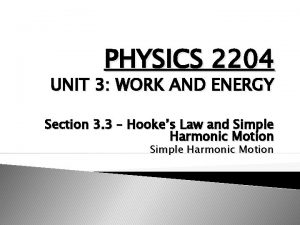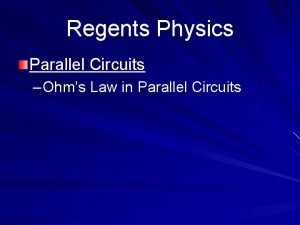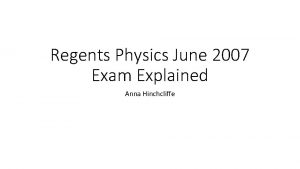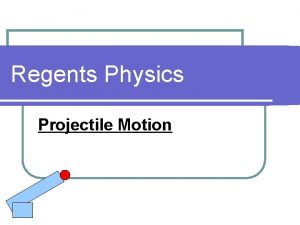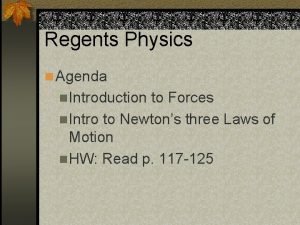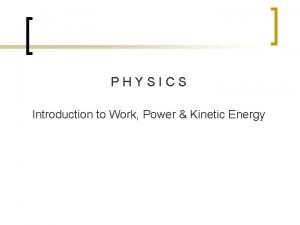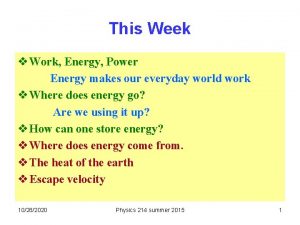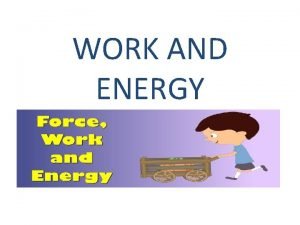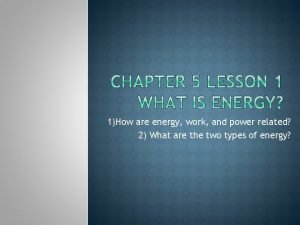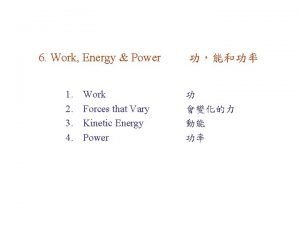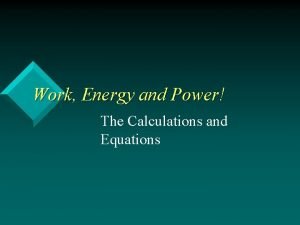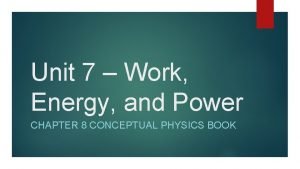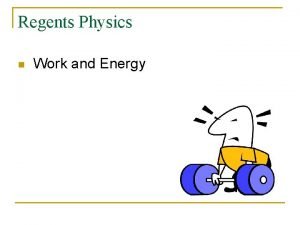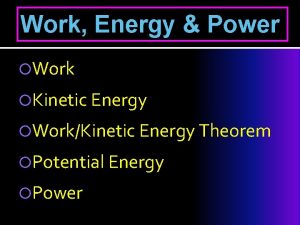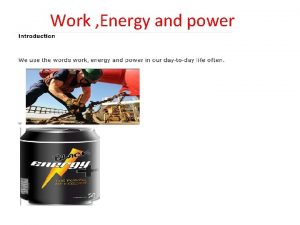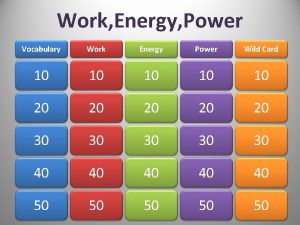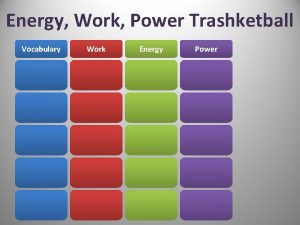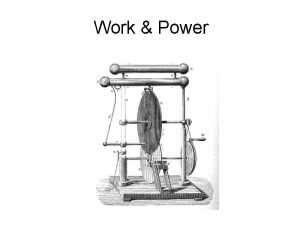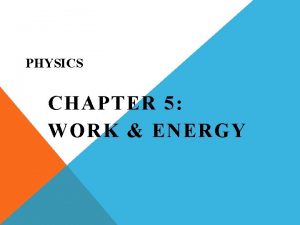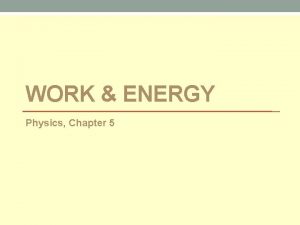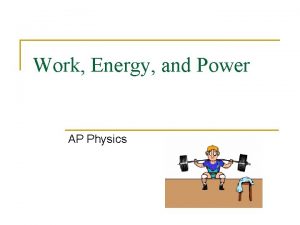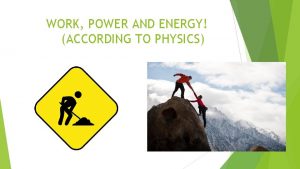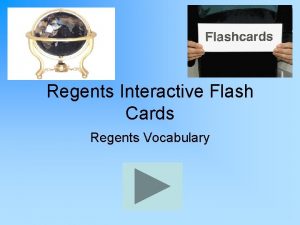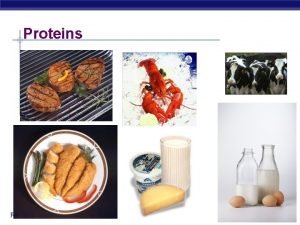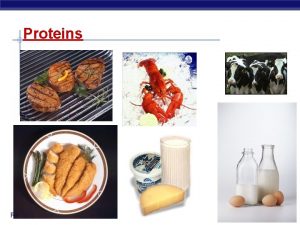Regents Physics Mr Rockensies Energy Work Power Introduction



























- Slides: 27

Regents Physics Mr. Rockensies Energy, Work & Power

Introduction to Energy How does energy manifest itself physically?

What is energy? Energy is the ability to do Work. Energy exists in several different forms. Almost all energy on Earth can be traced back to the Sun. Examples: Mechanical, Thermal (Heat), Chemical, Nuclear, Electromagnetic, Kinetic, Potential

What is Work? Work is a measure of the amount of energy used to move an object. Mathematically: Work = Force • displacement Because we are multiplying two vectors, we end up with a scalar quantity – Work is a scalar quantity. Work is only done when the Force and the displacement are in the SAME direction.

Unit for work: Work = F • d = Newton • m To simplify this, we use Joules (J). 1 J = 1 N • m All energy quantities will be measured in Joules.

Work and Friction When friction is present, energy in a system is lost because of it. When two objects come into contact and move past each other, energy is given off in the form of HEAT – this is due to FRICTION.

What is Power? Power is the rate at which energy is used, transformed, or transferred. Power = Work/time AND Power = Velocity • Force Power = Force • Distance time Units: Watts = Joules/second = N • m = kg • m 2 s s 3 We measure Power in Watts to simplify the units

What is horsepower then? A measure of the amount of energy expended by the average horse over a given period of time. One horsepower is equal to 746 Watts, but depending on how you are using horsepower, it is up for debate.

Practice Problems

Practice More

More Practice

MORE!


Law of Conservation of Energy cannot be created or destroyed; it can only change forms.

Conservation in Free Fall Ei = E f PEi = PEf + Kef mghi = mghf + 1/2 mvf 2 ghi – ghf = v 2/2 If an object starts from some initial height and enters free fall, its initial Potential Energy will equal the sum of its final Potential Energy and Kinetic Energy m initial m final Δhi Δhf vf

Energy is a scalar quantity Because energy is a scalar , direction doesn’t matter, and this works for curved motion as well m hi vf m hf

Hill slides and roller coasters are the same EA = E B = E C PEA + KEA = PEB + KEB = … A C h. A B h. C

Pendulum vi = 0 Kei = 0 All PE Etop = Ebottom PE = KE vf is max KE is max No PE

Springs PE = 1/2 kx 2 Ei = E f Pes = Kecart 1/2 kx 2 = 1/2 mv 2 KE = 1/2 mv 2

Systems with Friction Initial Mechanical energy (PE + KE) becomes final mechanical energy plus some internal energy, converted by friction. (PE + KE + Q) Q = internal energy, usually heat, caused by friction height reached with no friction height reached with friction

Summary In a closed isolated system, what happens to the gravitational potential energy of an object as it falls? the kinetic energy? the total energy? Does the amount of energy an object has change if the object changes direction? How does Potential Energy change if a spring is compressed more? When is Kinetic Energy the greatest for a swinging pendulum?

Energy Conservation Practice

Energy Conservation Practice

Energy Conservation Practice

Energy Conservation Practice

Energy Conservation Practice

Energy Conservation Practice
 0kei0
0kei0 Joule units
Joule units Physics 2204 unit 3: work, power, energy
Physics 2204 unit 3: work, power, energy Physics 03-02 potential energy and conservative forces
Physics 03-02 potential energy and conservative forces Regents physics circuits
Regents physics circuits June 2010 physics regents answers
June 2010 physics regents answers Projectile motion regents questions
Projectile motion regents questions What is inertia
What is inertia Work versus power
Work versus power Regents biology food chains and energy in ecosystems
Regents biology food chains and energy in ecosystems Kinetic energy formula
Kinetic energy formula Physics 1
Physics 1 Sources of chemical energy
Sources of chemical energy Power trianlge
Power trianlge Work, power and energy activities
Work, power and energy activities Work done define
Work done define How are energy work and power related
How are energy work and power related Work power energy and machines
Work power energy and machines W=fdcosθ meaning
W=fdcosθ meaning Work power and energy
Work power and energy Work energy power equations
Work energy power equations Jenis usaha apa
Jenis usaha apa Chapter 4 section 1 work and machines answer key
Chapter 4 section 1 work and machines answer key Work and energy section 2 describing energy
Work and energy section 2 describing energy Energy energy transfer and general energy analysis
Energy energy transfer and general energy analysis Energy energy transfer and general energy analysis
Energy energy transfer and general energy analysis Why does it happen
Why does it happen University physics with modern physics fifteenth edition
University physics with modern physics fifteenth edition


